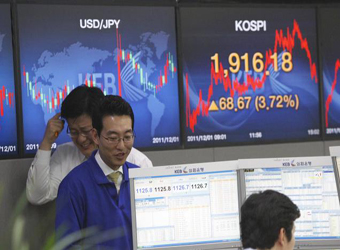Asian markets wavered on Monday, the first trading day of the New Year, in very thin holiday trade.
The benchmark Kospi was nearly flat, edging up 0.03 percent, while the Kosdaq slipped 0.11 percent. The market had opened at 10:00 a.m. local time, one hour later than usual trading hours.
The South Korean won was weaker against the dollar, at 1,207.33 as of 2:20 p.m. local time, compared with the pair trading as low as 1.197.04 last week.
Other major Asian financial markets, including Australia, Japan, China and Hong Kong, were shut for the New Year’s holiday.
In stock news, smartphone maker Samsung Electronics was up 0.17 percent, after its Chief Executive Kwon Oh-hyun said to employees in a New Year’s speech that no compromises should be made on the quality of its products. Kwon also made calls for employees to improve manufacturing processes and safety inspections.
This year, Samsung’s reputation and profit took a big hit after multiple reports of its latest smartphone model’s faulty batteries exploding. Even after a product recall and exchange, the new devices continued to catch fire, ultimately resulting in Samsung killing the Note 7 model.
South Korean automakers Hyundai Motor and its affiliate Kia Motors announced a higher combined sales target in 2017 of 8.25 million vehicles globally, compared with its 2016 goal of 8.13 million vehicles. The companies were expected to release 2016 sales figures later on Monday. Kia said it fell short of its 2016 target, without providing details, Reuters reported on Monday.
Hyundai and Kia Motors were also preparing to boost vehicle supply to the U.S. and China this year. Hyundai Motor’s stock was up 2.74 percent, while Kia Motors’ gained 0.51 percent.
Shares of SK Innovation were up 0.68 percent, after its president said Sunday that the conglomerate would invest up to 3 trillion won ($2.49 billion) in the chemicals, oil exploration and battery businesses to boost growth in 2017.
South Korean exports in December grew for the second straight month, up 6.4 percent year-on-year, while imports rose 7.3 percent, leading to a trade surplus of $7 billion and adding to hopes that global trade is seeing a firm turnaround.
The country’s exports to China also rose 9.6 percent, although shipments to the U.S. slipped 2.3 percent after climbing 3.8 percent in November.
Investors were likely to continue tracking South Korea’s complicated political scandal, which has led to President Park Geun-hye’s impeachment by parliament and the arrest of several high-ranking officials. South Koreans also gathered to protest for the ninth straight week over the New Year weekend, calling for the immediate resignation of President Park.
Park emerged from a month-long seclusion on Sunday to publicly deny charges of wrongdoing and to say the corruption allegations against her were “fabrication and falsehood.”
The country was also battling to contain an avian flu outbreak since November, which has led to widespread culling of poultry in South Korea.
Indian shares were in negative territory, with the Nifty 50 down 0.47 percent and the Sensex index off 0.37 percent. The rupee was softer against the greenback, with the pair trading at 68.01 by 10:45 am IST.
India’s reform program to remove 500 and 1,000 rupee bank notes from the financial system, also known as demonetization, ended on Friday. While the move was aimed at targeting black money and counterfeit notes, it also hit parts of the economy, especially in poorer rural areas, which are mostly cash-based.
In the short term, India’s demonetization program could weigh on economic growth and corporate earnings, but could be a positive in the long run as it puts a stop to black market activity.
In other news, Indian state oil refiners rose on a petrol price hike, with Indian Oil up 0.78 percent, Bharat Petroleum gaining 0.87 percent and Hindustan Petroleum climbing 0.67 percent. Petrol prices were raised by 1.29 rupees per liter, while diesel prices were up 0.97 rupees per liter, according to Indian Oil Corporation.
On Wall Street, U.S. stocks ended Friday’s session sluggish, with losses led by technology stocks, but major indexes still posted solid gains for 2016.
For the full year, the Dow Jones industrial average surged 13.4 percent to close at 19,762.6, still shy of the key psychological level at 20,000, while the S&P 500 closed up 9.5 percent for the year at 2,238.83, and the Nasdaq composite gained 7.5 percent in 2016 to 5,383.12.
Source: CNBC
